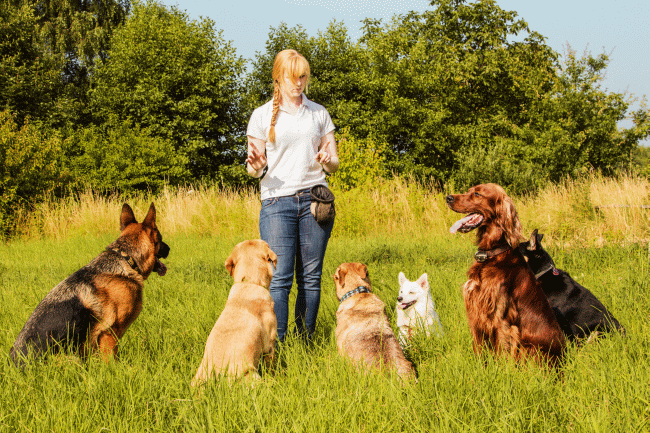Master Necessary Commands: Reliable Pet Training Facilitated
Efficient dog training is a fundamental facet of responsible pet ownership, and grasping essential commands offers as the structure for a harmonious relationship between handler and dog. Recognizing the nuances of canine actions and the training process is essential; nonetheless, the journey to a well-trained dog typically offers unanticipated obstacles that require interest.
Understanding Your Pet's Habits
To realize the nuances of efficient canine training, it is vital to damage down and analyze your pet's behavior. Dog training. Understanding the motivations behind your pet's actions is vital; habits can come from reaction, anxiety, enjoyment, or a desire for attention. By observing your pet in numerous situations, you can identify patterns that might indicate underlying emotions or needs
As an example, a canine that barks excessively might be sharing dullness, stress and anxiety, or a demand for social interaction. Alternatively, a pet that shows harmful behaviors may be looking for stimulation or remedy for stress. Identifying these triggers allows you to customize your training technique efficiently.
Additionally, it is vital to take into consideration the dog's type features, as they can affect habits substantially. Some breeds are predisposed to details traits, such as herding or securing impulses, which can influence their reactions to certain stimuli.
Lastly, uniformity in your responses to your canine's actions cultivates a much better understanding between you and your pet dog. This common understanding is foundational for constructing depend on and helping with a reliable training process that supports both behavior modification and positive support.
Crucial Commands to Teach
Teaching necessary commands is a fundamental element of reliable canine training, supplying the structure for a mannerly and receptive animal. These commands not just improve communication between the owner and the dog however additionally guarantee safety in various settings.
One of the most vital commands include "Sit," which encourages your pet to continue to be stationary and tranquil; "Keep," which enhances the concept of staying in one location up until released; and "Come," which is important for recalling your canine from potentially dangerous circumstances. "Down" educates pet dogs to relax, advertising relaxation and control, while "Leave it" assists protect against pets from getting unsafe or unwanted items.
" Heel" is one more essential command that urges your canine to stroll very closely next to you, enhancing chain good manners. "No" serves as a vital boundary-setting command, assisting to fix unfavorable habits.
Training Strategies for Success
Effective canine training depends heavily on using a range of methods that satisfy both the pet's discovering design and the owner's training objectives. One key method is positive support, which entails gratifying wanted behaviors with deals with, praise, or play. This method urges the dog to duplicate those behaviors, cultivating a solid bond between proprietor and pet.

One more efficient technique is remote control training, where a distinct noise, made by a remote control, notes the specific minute a dog carries out a preferred activity. This accurate timing helps dogs link the habits with the reward, enhancing their understanding.
Uniformity is important in all training approaches. Establishing clear commands and preserving the very same signs assists the pet understanding assumptions more rapidly. Additionally, brief, interesting training sessions prevent boredom and increase retention.
Including socializing opportunities is additionally essential. Exposing canines to different environments, people, and various other animals helps them create confidence and adaptability.
Lastly, perseverance plays a substantial role in successful training - Dog training. Each dog finds out at their very own rate, and comprehending this can bring about a much more enjoyable training experience for both the proprietor and the pet. Carrying out these strategies will certainly set the structure Homepage for efficient canine training
Common Challenges and Solutions
Regardless of the ideal training techniques, pet dog owners commonly experience usual difficulties that can impede progress. When household participants use different commands for the same habits, it puzzles the pet dog, leading to inconsistent feedbacks.

Furthermore, some pets might exhibit stubbornness or lack motivation. This can usually be attended to by incorporating favorable support techniques, such as deals with or appreciation, to motivate desired actions. Tailoring benefits to what your canine finds most motivating can considerably boost their involvement.
Finally, anxiety or anxiety can hamper development in training. Identifying signs of stress and changing the training rate appropriately is important. Employing gradual direct exposure to been afraid stimuli can assist construct confidence with time, helping with an extra reliable training experience.
Maintaining Uniformity and Persistence
Consistency and patience are extremely important in dog training, as they form the structure for accomplishing lasting behavior changes. Dogs grow on regular and clear assumptions; therefore, preserving a consistent approach in commands, benefits, and adjustments is crucial.
Just as important is the function of patience. Training a dog is not an immediate process; it needs time and repetition. Pets, a lot like humans, have varying learning rates and may not understand commands promptly. Trainers should acknowledge this and stay tranquil, providing encouragement instead of disappointment. Positive reinforcement plays an important function right here, rewarding desired actions and helping to foster a relying on partnership between the pet and trainer.
Final Thought
Understanding essential commands is fundamental to reliable dog training, my response fostering boosted interaction and strengthening favorable habits (Dog training). Ultimately, a trained canine not only exhibits good actions however likewise develops confidence, adding to a harmonious relationship in between the dog and its proprietor.